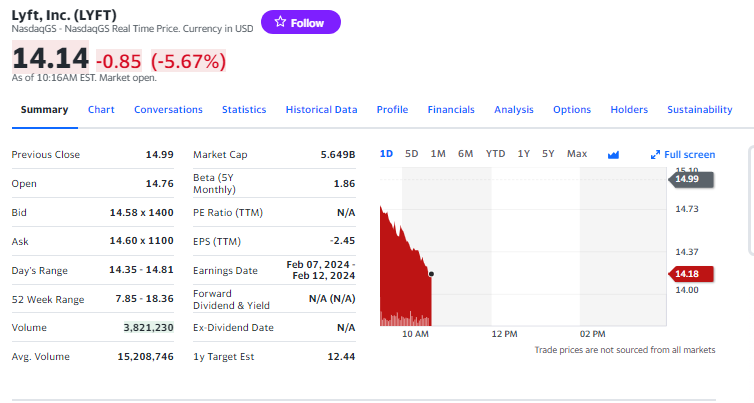This website and its content are not intended to provide professional or financial advice. The views expressed here are based solely on the writer’s opinion, research, and personal experience, and should not be taken as factual information. The author is not a financial advisor and lacks relevant certifications in that regard. We highly recommend consulting a qualified financial advisor before making any investment decisions, as the information presented on this site is general in nature and may not be tailored to individual needs or circumstances.
Introduction to Lyft’s Market Position
Lyft, a notable player in the ride-sharing industry, has consistently been in the spotlight alongside its main competitor, Uber. As of the latest update, Lyft’s stock stands at $14.40, showcasing the dynamic nature of this market. This price point is crucial for investors and market analysts alike, as it represents the current valuation of a company that has experienced significant fluctuations in its stock price.
Lyft’s journey in the stock market has been marked by various ups and downs, reflective of both its internal strategic decisions and the external economic environment. Despite the challenges, Lyft has managed to maintain a significant presence in the ride-sharing sector, distinguishing itself from Uber with unique strategies and business focuses. While Uber has expanded into areas like food delivery and freight services, Lyft has remained focused primarily on its mobility services.
By analyzing the company’s stock performance, comparing it with its competitors, and understanding the underlying factors influencing its market position, readers can gain a deeper insight into Lyft’s role in the ever-evolving landscape of ride-sharing services.

Recent Stock Performance Analysis
Lyft’s stock performance has been a subject of interest for investors and analysts. Tracking its price trends offers insights into the company’s financial health and market perception. Over recent months, Lyft’s stock has experienced significant fluctuations, reflecting broader market trends and internal company developments.
Stock Price Trends
A crucial aspect to consider is the trend in Lyft’s stock prices. Historically, the stock has shown both peaks and troughs, indicative of the volatile nature of the tech and mobility sectors. For instance, Lyft’s stock experienced notable dips and rises over the past year, affected by various factors including investor sentiment, market competition, and global economic conditions.
Impact of Market Trends
The ride-sharing industry is heavily influenced by factors such as regulatory changes, technological advancements, and competitive dynamics. These factors, coupled with Lyft’s operational decisions, have a direct impact on its stock performance. For example, regulatory challenges in key markets or innovations in mobility services can either boost investor confidence or lead to uncertainty, thus affecting the stock price.
Understanding Lyft’s recent stock performance requires an examination of these various factors. It’s important to look beyond mere price movements and explore the underlying reasons contributing to these changes. This approach provides a more comprehensive understanding of Lyft’s current financial standing and future potential in the stock market.
Analyst Predictions and Forecasts for 2024

The future of Lyft’s stock is closely watched by analysts who provide predictions and forecasts based on various economic and company-specific factors. These forecasts are essential for investors to understand the potential direction of the stock in the coming year.
Expert Forecasts
Many financial experts and analysts regularly update their predictions for Lyft’s stock. These forecasts typically include expected price targets, which are influenced by the company’s earnings reports, market trends, and other financial indicators. For instance, some analysts may predict a rise in Lyft’s stock based on positive growth in its core ride-sharing business, while others may forecast a decline due to competitive pressures.
Potential Market Movements
The ride-sharing market is evolving, and Lyft’s position within it is subject to change. Analysts often look at market trends, such as consumer behavior shifts, technological advancements, and regulatory landscapes, to gauge Lyft’s future performance. Understanding these elements is crucial for predicting how the stock might perform in 2024 and beyond.
For accurate and current analyst forecasts and predictions on Lyft’s stock for the year 2024, investors are encouraged to refer to financial news websites and platforms where these analyses are regularly updated.
Lyft’s Business Model and Revenue Streams
Lyft’s business model is a critical aspect to understand when analyzing its financial health and stock potential. As a major player in the ride-sharing industry, Lyft’s revenue streams are primarily derived from its core service of providing rides to customers. This model hinges on the network of drivers who use their personal vehicles to offer rides, facilitated through Lyft’s technology platform.
Key Revenue Sources
The primary source of Lyft’s income comes from the fees charged on each ride, which constitute a significant portion of its overall revenue. Additionally, the company has explored other revenue streams, such as partnerships with other businesses, and has made efforts to innovate within its service offerings.
Business Expansion and Diversification
While Lyft has historically focused on ride-sharing, there are indications of potential diversification. This could include exploring new markets or investing in related technology such as autonomous driving. Such expansion strategies could influence Lyft’s revenue growth and, consequently, its stock value.
Understanding Lyft’s business model and revenue streams is crucial for investors to assess the company’s long-term financial viability and stock potential.
Challenges and Opportunities for Lyft
Lyft, like any major company, faces its share of challenges and opportunities that can impact its stock value. Understanding these elements is key for investors and analysts alike.
Key Challenges
Lyft operates in a highly competitive market, with Uber being its primary competitor. This competition necessitates continuous innovation and adaptation. Additionally, regulatory challenges in various markets can impact operations and profitability. The evolving nature of the ride-sharing industry also means that Lyft must stay ahead of technological advancements and changing consumer preferences.
Potential Growth Opportunities
Despite these challenges, Lyft has significant opportunities for growth. The company’s potential expansion into new markets or services, like autonomous vehicles, represents areas for potential revenue growth. Lyft’s commitment to sustainability and community-focused initiatives can also enhance its brand appeal and customer loyalty.
Recognizing these challenges and opportunities is crucial for anyone interested in Lyft’s stock, as they play a significant role in shaping the company’s future.
Investor Sentiment and Market Perceptions
Investor sentiment is a vital factor in Lyft’s stock performance. It reflects how investors feel about the company’s future prospects and can significantly influence stock prices.
Factors Influencing Investor Sentiment
Investor confidence in Lyft is shaped by a variety of factors, including financial performance, market competition, and company news. Positive developments, such as strong earnings reports or successful market expansions, can boost sentiment. Conversely, negative news or underwhelming performance can lead to decreased confidence.
Market Perception of Lyft
Market perception involves how investors view Lyft in the context of the broader market and its competitors. This perception is influenced not just by financial performance but also by Lyft’s strategic decisions, market position, and potential for future growth.
Understanding investor sentiment and market perception is crucial for gauging Lyft’s stock attractiveness and potential future performance.
Long-term Investment Outlook for Lyft
When considering Lyft for long-term investment, it’s essential to balance immediate performance with future prospects and sustainability. Lyft’s stock has shown resilience, but also faces challenges in a competitive and evolving market.
Future Prospects
Lyft’s long-term potential hinges on its ability to innovate, expand into new markets, and adapt to consumer and technological changes. The company’s focus on its core mobility services, while exploring new avenues like autonomous vehicles, could be crucial for future growth.
Sustainability and Investment Viability
The sustainability of Lyft’s business model and its adaptability in the face of market shifts will be key determinants of its long-term investment viability. Investors need to consider these factors, along with Lyft’s financial health and market position, to make informed decisions.
This outlook provides a balanced perspective on Lyft as a potential long-term investment, considering both its current performance and future growth potential.
Conclusion: What the Future Holds for Lyft
As we look towards the future of Lyft, it’s clear that the company stands at a pivotal point. With the ride-sharing industry evolving rapidly, Lyft’s ability to innovate, adapt to regulatory changes, and enhance its service offerings will be crucial. Investors should monitor Lyft’s financial health, market competition, and strategic initiatives to gauge its potential for growth and long-term viability.
While challenges exist, the opportunities for Lyft in the expanding mobility market are significant. The future for Lyft appears to hold a blend of uncertainties and possibilities, making it a noteworthy stock for investors to watch.
StockHax strives to provide unbiased and reliable information on cryptocurrency, finance, trading, and stocks. However, we cannot provide financial advice and urge users to do their own research and due diligence.
Read More


